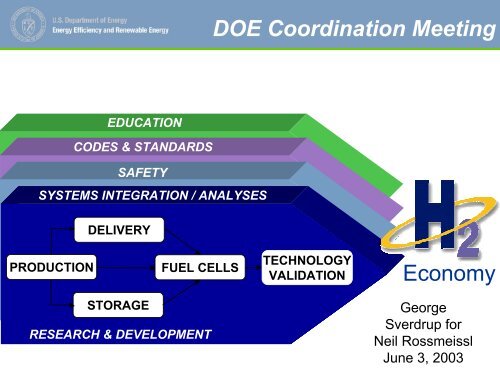PDF 623 KB - EERE
PDF 623 KB - EERE
PDF 623 KB - EERE
- No tags were found...
Create successful ePaper yourself
Turn your PDF publications into a flip-book with our unique Google optimized e-Paper software.
DOE Coordination MeetingEDUCATIONCODES & STANDARDSSAFETYSYSTEMS INTEGRATION / ANALYSESDELIVERYPRODUCTIONFUEL CELLSTECHNOLOGYVALIDATIONEconomySTORAGERESEARCH & DEVELOPMENTGeorgeSverdrup forNeil RossmeisslJune 3, 2003
Cross-cutting FunctionsSafety, Codes and StandardsEDUCATIONCODES & STANDARDSSAFETYSYSTEMS INTEGRATION / ANALYSESDELIVERYPRODUCTIONFUEL CELLSTECHNOLOGYVALIDATIONEconomySTORAGERESEARCH & DEVELOPMENTNeil Rossmeissl
Hydrogen Codes &Standards
Hydrogen Codes & Standards:Goal & ObjectivesGoal : Facilitate the creation and adoption of model building codes andequipment standards for hydrogen systems in commercial, residential, andtransportation applications. Provide technical resources to harmonize thedevelopment of international standards among IEC, ISO, and GRPE.Objectives• Complete the drafting of hydrogen building codes for the National FireProtection Association’s (NFPA’s) hearing cycle. Facilitate in the adoption ofthe International Code Council’s codes in three key regions: North East, Mid-Atlantic, and Midwest, by 2005;• Complete the adoption of the International Standards Organization’s standardsfor hydrogen refueling and storage, by 2006;• Complete and adopt the revised NFPA 55 standard for hydrogen storage withdata from Technology Validation projects and the experimental project forunderground bulk storage of hydrogen, by 2008;• Complete U.S. adoption of a Global Technical Regulation (GTR) for hydrogenfuel cell vehicles under the Global Regulation on Pollution and EfficiencyProgram, by 2010.
Hydrogen Codes & Standards:Key MilestonesMilestone3411243032DescriptionCollaborate with ICC and NFPA to develop first-order continuingeducation for code officials.Establish a coordination plan with education sub-programactivity to run workshops for state and local officials.Initiate negotiations with critical Standard DevelopmentOrganizations and develop draft generic licensing agreementand estimate of costs.With industry and code officials, develop templates ofcommercially viable footprints for fueling stations thatincorporate underground and above ground storage of liquidand gaseous hydrogen.Implement analytical and experimental program to support thesubmittal of a comprehensive vehicular safety standard as aregulation.Implement research program to support five new technicalcommittees for the key critical standards including fuelinginterface, power block, and fuel storage.Date (FY)3Q, 20043Q, 20044Q, 20031Q, 20044Q, 20054Q, 2006
Hydrogen SafetyNeil Rossmeissl
Hydrogen Safety:Goal & ObjectivesGoal : Develop and implement the practices and procedures that willensure safety in the operation, handling and use of hydrogen andhydrogen systems for all DOE funded projects.Objectives• Draft a comprehensive safety plan to be completed in collaboration withindustry. The plan will initiate the research necessary to fill safety informationgaps and enable the formation of a Safety Review Panel, by 2004;• Integrate safety procedures into all DOE project funding procurements. Thiswill ensure that all projects that involve the production, handling, storage, anduse of hydrogen incorporate project safety requirements into theprocurements, by 2005;• Publish a handbook of Best Management Practices for Safety. TheHandbook will be a “living” document that will provide guidance for ensuringsafety in future hydrogen endeavors, by 2010.
Hydrogen Safety: Key MilestonesMilestone212172131DescriptionDevelop in collaboration with NASA, DOT, Commerce,a search protocol on component and system safety.Assemble panel of experts in hydrogen safety toprovide expert technical guidance to funded projects.Identify areas of additional study and research forfailure modes scenarios.Gather and review data to support the inclusion ofhydrogen safety in procurements.Establish annual review criteria for safety.Date (FY)1Q, 20044Q, 20033Q, 20044Q, 20034Q, 2004
















